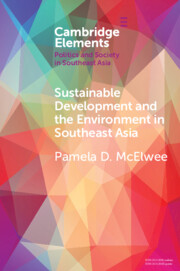Refine search
Actions for selected content:
177 results
Forest dynamics and ecosystem collapse in open-access problems
-
- Journal:
- Environment and Development Economics , First View
- Published online by Cambridge University Press:
- 29 August 2025, pp. 1-20
-
- Article
-
- You have access
- Open access
- HTML
- Export citation

Sustainable Development and the Environment in Southeast Asia
-
- Published online:
- 25 August 2025
- Print publication:
- 25 September 2025
-
- Element
- Export citation
12 - Forests and Biodiversity
- from Part III - Application to Environmental Sustainability
-
- Book:
- Economics for a Sustainable World
- Published online:
- 14 July 2025
- Print publication:
- 12 June 2025, pp 351-384
-
- Chapter
- Export citation
Severe reduction in the distribution of the threatened New Caledonian Crow Honeyeater Eugymnomyza aubryana
-
- Journal:
- Bird Conservation International / Volume 35 / 2025
- Published online by Cambridge University Press:
- 11 June 2025, e18
-
- Article
- Export citation
A species under siege: modelling habitat suitability for the bear cuscus Ailurops ursinus in South Sulawesi
-
- Journal:
- Oryx , First View
- Published online by Cambridge University Press:
- 30 May 2025, pp. 1-12
-
- Article
-
- You have access
- Open access
- HTML
- Export citation
20 - The League for Nature
-
-
- Book:
- The Cambridge History of International Law
- Published online:
- 01 May 2025
- Print publication:
- 29 May 2025, pp 650-685
-
- Chapter
- Export citation
Call it A ‘Wash‘? Historical Perspectives on Conundrums of Technological Modernization, Flood Amelioration and Disasters in Modern Japan
-
- Journal:
- Asia-Pacific Journal / Volume 12 / Issue 7 / February 2014
- Published online by Cambridge University Press:
- 14 March 2025, e2
-
- Article
-
- You have access
- Open access
- Export citation
Tropical forests and cocoa production: synergies and threats in the chocolate market
-
- Journal:
- Environmental Conservation / Volume 52 / Issue 1 / March 2025
- Published online by Cambridge University Press:
- 30 January 2025, pp. 20-30
-
- Article
-
- You have access
- Open access
- HTML
- Export citation
24 - From Deforestation to Sustainable Development
- from Part III - Diplomacy
-
- Book:
- Five Times Faster
- Published online:
- 24 October 2024
- Print publication:
- 07 November 2024, pp 314-326
-
- Chapter
- Export citation
Distinguishing potential and effective additionality of forest conservation interventions
-
- Journal:
- Environment and Development Economics / Volume 29 / Issue 6 / December 2024
- Published online by Cambridge University Press:
- 15 October 2024, pp. 518-538
-
- Article
- Export citation
Small forest patches in West Africa: mapping how they are changing to better inform their conservation
-
- Journal:
- Environmental Conservation / Volume 51 / Issue 4 / December 2024
- Published online by Cambridge University Press:
- 14 October 2024, pp. 254-262
-
- Article
-
- You have access
- Open access
- HTML
- Export citation
Environmental enforcement, property rights, and violence: evidence from the Brazilian Amazon
-
- Journal:
- Journal of Institutional Economics / Volume 20 / 2024
- Published online by Cambridge University Press:
- 27 August 2024, e27
-
- Article
-
- You have access
- Open access
- HTML
- Export citation
Current knowledge of amphibian diversity in Sumatra, and its significance for conservation
-
- Article
-
- You have access
- Open access
- HTML
- Export citation
Pitfalls for the sustainability of forest transitions: evidence from Southeast Asia
-
- Journal:
- Environmental Conservation / Volume 51 / Issue 3 / September 2024
- Published online by Cambridge University Press:
- 23 April 2024, pp. 152-162
-
- Article
-
- You have access
- Open access
- HTML
- Export citation
Agricultural subsidies: cutting into forest conservation?
-
- Journal:
- Environment and Development Economics / Volume 29 / Issue 3 / June 2024
- Published online by Cambridge University Press:
- 06 February 2024, pp. 179-205
-
- Article
-
- You have access
- Open access
- HTML
- Export citation
Forest loss during 2000–2019 in pygmy hippopotamus (Choeropsis liberiensis) habitats was driven by shifting agriculture
-
- Journal:
- Environmental Conservation / Volume 51 / Issue 1 / March 2024
- Published online by Cambridge University Press:
- 06 December 2023, pp. 55-63
-
- Article
-
- You have access
- Open access
- HTML
- Export citation
Was global deforestation under lockdown?
-
- Journal:
- Environment and Development Economics / Volume 29 / Issue 2 / April 2024
- Published online by Cambridge University Press:
- 04 December 2023, pp. 83-106
-
- Article
- Export citation
Projecting forest cover in Madagascar's protected areas to 2050 and its implications for lemur conservation
-
- Article
-
- You have access
- Open access
- HTML
- Export citation
9 - Historical Context
- from Part III - Promoting Biocultural Diversity and Resilience: A Stewardship Approach to Conservation
-
- Book:
- Conservation in the Context of a Changing World
- Published online:
- 28 September 2023
- Print publication:
- 12 October 2023, pp 223-245
-
- Chapter
- Export citation
MASS DEFORESTATION AS A CRIME AGAINST HUMANITY?
-
- Journal:
- International & Comparative Law Quarterly / Volume 72 / Issue 4 / October 2023
- Published online by Cambridge University Press:
- 27 October 2023, pp. 1013-1046
- Print publication:
- October 2023
-
- Article
- Export citation
